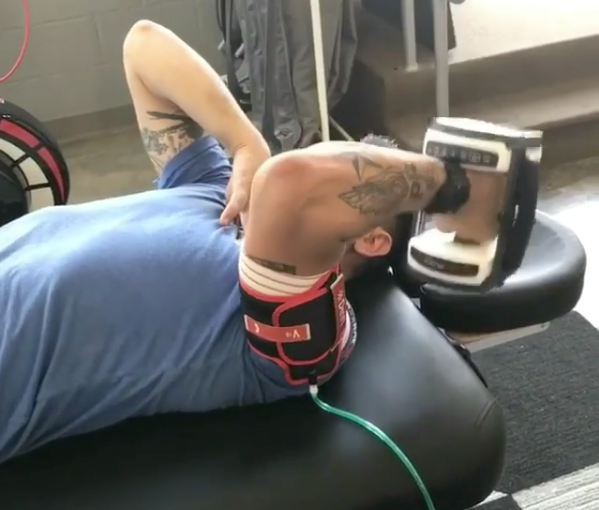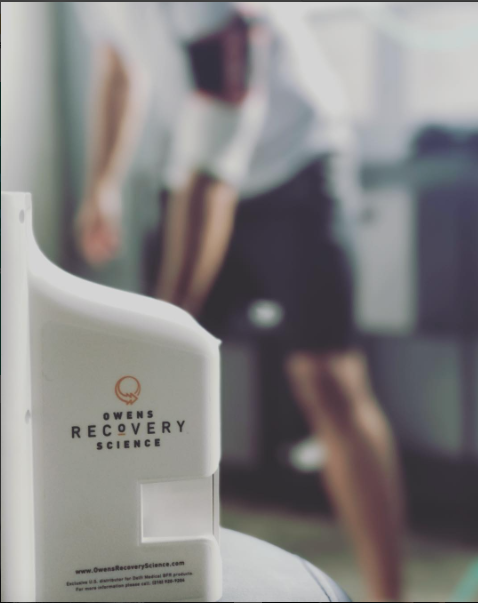Personalized Blood Flow Restriction: A Paradigm Shift in Human Performance
Oct 11, 2017
To put it bluntly, being strong makes life easier. Humans don’t have the ability to create more muscle fibers (hyperplasia), so in order to get stronger we have to work tediously to increase the size of our existing muscle fibers (hypertrophy). According to the American Academy of Sports Medicine, gaining strength through hypertrophy takes 8-12 weeks of moderate to high intensity resistance training (>65% of your one rep max) utilizing 8-10 upper and lower body exercises at a rate 2-3 times per week.
A relatively easy formula to follow; right? Well, what happens when you are recovering from an injury and can’t safely use loads heavy enough to improve strength and size? Or when you’re an athlete who is in-season and can’t tolerate the drop in performance associated with the muscle soreness that follows heavy lifting?
Up until now those have been troubling questions for medical professionals and strength coaches alike. However, there is a new tool with over 160 peer reviewed research studies and documented success across the military, college, and professional sports arenas; something that is creating increased size and strength in as little as two weeks and is completely changing the game of how professionals approach rehab and sports performance…Personalized Blood Flow Restriction Training (PBFRT).
What is Personalized Blood Flow Restriction Training and How Does it Work?

PBFRT is the brief and intermittent use of a tourniquet in order to restrict the amount of blood flow from coming into your limb (arterial flow) while performing low-load resistance training. There are numerous types of blood flow restriction devices available, but the gold standard occlusion device is the Delphi Personal Occlusion Tourniquet. The Delphi Personal Occlusion Tourniquet the only device have FDA approval to be safely used for medical use and is essentially a modified surgical tourniquet that contains a doppler system. This doppler system allows so you read a person’s arterial flow in live time, so you know exactly how much blood you are occluding, and it will adjust its pressure automatically throughout an exercise to maintain a designated percentage of occlusion that is personalized to each individual person.
The way PBFRT works is it reduces the amount of oxygenated blood reaching a working muscle in order to trick your body into thinking it’s working at a higher intensity than it actually is. By using this form of engineered suffering you’re able to use extremely light resistance and still get the same increases in size and strength as lifting at higher intensities with heavy weight! Exactly how this happens is laid out below:
- Occluding your limb creates an anaerobic environment by limiting the amount of oxygenated blood that reaches a working muscle.
- This anaerobic environment stimulates your fast twitch muscle fibers (the fibers responsible for power, speed, and strength).
- In an anaerobic environment with your fast twitch muscle fibers activated, a convoluted process starts called the Cori Cycle, which leads to the production of lactate in the muscles (fun fact: lactate production creates that burning sensation you feel).
- Because your limb is occluded, the lactate being produced begins to pool in the working muscles, which signals multiple metabolites leading to protein synthesis, muscle stem cells, capillary beds, and a 290% increase in human growth hormone (HGH).
So who exactly would benefit from Personalized Blood Flow Restriction Training?
Prehabilitation
- Contrary to popular belief, HGH does not directly relate to increased muscle size or strength gains. Instead it increases collagen synthesis, which serves as a protective role to muscle tendons and ligaments. In other words, the significantly increased levels of HGH can lead to improved tendon health, which can help prevent common overuse injuries such as strains and tendonitis.
Rehabilitation
- Muscle breakdown (atrophy) after a surgery or injury happens incredibly fast. For example, when you’re injured or you’re not allowed to put any weight through one of your limbs, in as little as two weeks that limb goes into a state of anabolic resistance and protein synthesis shuts down leading to a 30% loss of muscle mass in that limb!
- Obviously, this is extremely problematic and slows down recovery from an injury dramatically. However, with PBFRT we now have the ability to combat that significant muscle loss because we are able to use low intensity and weight levels that are safe and tolerable to the patient and get the same increases in muscle size and strength as lifting at 65% of your one rep max or higher.
- A great example of just how beneficial PBFRT can be for patients rehabbing from injury comes from Dr. Zach Long who was working with an elite level olympic lifter after tearing his ACL. With this type of injury, more than 65% of patients demonstrate quadricep weakness even a year out from surgery. However, Dr. Long’s patient’s surgical leg became one inch larger than his healthy leg in just three months time after his surgery!
Sports Performance
- PBFRT has shown numerous benefits to enhancing sports performance, but perhaps the most documented is the ability for athletes to maintain muscle size and strength without a the dip in performance caused by muscle soreness. This is possible because there is no muscle tissue breakdown associated with PBFRT since the intensity is kept so low.
- This is a great way for barbell, endurance, and in-season athletes to compliment their current training programs without worrying about over-training.
- PBFT has also been shown to have a profound effect on your aerobic capacity as well by increasing your VO2 max and capillary beds.
- Meaning research has demonstrated the ability to improve both your cardiovascular endurance and muscular size simultaneously!
Personalized blood flow restriction training has been one of the largest advancements for injury rehabilitation and sports performance and we are so excited to offer it at our clinic in Decatur, GA. Whether you are training through a nagging injury or preparing for your next triathlon, we would love to help you achieve your performance goals. Give us a call at 470-355-2106 or fill out the contact request form below and we will be happy to contact you.
Thanks for reading,
-Dr. Jake, PT, DPT
Let us help you figure out to live your best active life today!
Remember, Movement is Medicine!

